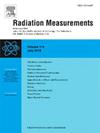Combined detection method of LET measurement using CR-39 and TLD in carbon ion radiotherapy
IF 2.2
3区 物理与天体物理
Q2 NUCLEAR SCIENCE & TECHNOLOGY
引用次数: 0
Abstract
The measurement of linear energy transfer (LET) distribution in carbon ion therapeutic fields is essential for optimizing beam quality control and enhancing therapeutic outcomes. To address the need for precise LET measurements, this study introduces a novel combined detector integrating CR-39 and thermoluminescent dosimeters (TLDs). Capitalizing on the respective strengths of each detector, a new method was developed to estimate LET spectra. Validation experiments and applications in both water and lung phantoms demonstrated that the combined detector significantly enhanced measurement accuracy compared to the use of either detector individually. The relative deviation in LETd measurements was controlled within 15 %. These findings suggest that the integrated detector system is highly effective for LET distribution measurements in carbon ion therapy and holds substantial potential for clinical applications.
CR-39与TLD在碳离子放疗中LET测量的联合检测方法
碳离子治疗场中线性能量传递(LET)分布的测量对于优化束流质量控制和提高治疗效果至关重要。为了满足精确LET测量的需求,本研究引入了一种集成CR-39和热释光剂量计(tld)的新型组合探测器。利用每个探测器各自的优势,开发了一种估计LET光谱的新方法。验证实验和在水和肺幻影中的应用表明,与单独使用任何一种检测器相比,组合检测器显着提高了测量精度。LETd测量的相对偏差控制在15%以内。这些发现表明,集成的检测器系统对于碳离子治疗中LET分布的测量是非常有效的,具有巨大的临床应用潜力。
本文章由计算机程序翻译,如有差异,请以英文原文为准。
求助全文
约1分钟内获得全文
求助全文
来源期刊

Radiation Measurements
工程技术-核科学技术
CiteScore
4.10
自引率
20.00%
发文量
116
审稿时长
48 days
期刊介绍:
The journal seeks to publish papers that present advances in the following areas: spontaneous and stimulated luminescence (including scintillating materials, thermoluminescence, and optically stimulated luminescence); electron spin resonance of natural and synthetic materials; the physics, design and performance of radiation measurements (including computational modelling such as electronic transport simulations); the novel basic aspects of radiation measurement in medical physics. Studies of energy-transfer phenomena, track physics and microdosimetry are also of interest to the journal.
Applications relevant to the journal, particularly where they present novel detection techniques, novel analytical approaches or novel materials, include: personal dosimetry (including dosimetric quantities, active/electronic and passive monitoring techniques for photon, neutron and charged-particle exposures); environmental dosimetry (including methodological advances and predictive models related to radon, but generally excluding local survey results of radon where the main aim is to establish the radiation risk to populations); cosmic and high-energy radiation measurements (including dosimetry, space radiation effects, and single event upsets); dosimetry-based archaeological and Quaternary dating; dosimetry-based approaches to thermochronometry; accident and retrospective dosimetry (including activation detectors), and dosimetry and measurements related to medical applications.
 求助内容:
求助内容: 应助结果提醒方式:
应助结果提醒方式:


